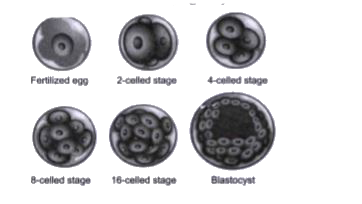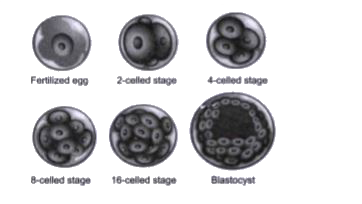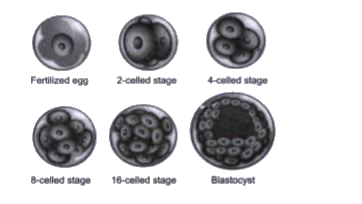Solid blastula is known as
Coeloblastula
Disocoblastula
Stereoblastula
Superficial blastula.
The correct Answer is:C
To solve the question "Solid blastula is known as," we can follow these steps:
1. Understand the term "blastula":
- A blastula is an early stage of embryonic development that follows the cleavage stage. It is typically a hollow sphere of cells surrounding a fluid-filled cavity known as the blastocoel.
2. Identify the types of blastulae:
- There are different types of blastulae based on their structure and the type of cleavage that occurs during development. Some common types include celioblastula, discoblastula, stereoblastula, and superficial blastula.
3. Define "solid blastula":
- A solid blastula refers to a type of blastula that lacks a blastocoel, which means it is not hollow. This type of blastula is characterized by the absence of a fluid-filled cavity.
4. Analyze the options given:
- A. Celioblastula: This type has a blastocoel.
- B. Discoblastula: This type is typically a disc-shaped blastula with a blastocoel.
- C. Stereoblastula: This type is solid and lacks a blastocoel, making it the correct answer.
- D. Superficial blastula: This type is also not solid and has a blastocoel.
5. Conclusion:
- Based on the definitions and characteristics of the types of blastulae, the solid blastula is known as stereoblastula.
Final Answer:
The solid blastula is known as C. stereoblastula.
---
- A blastula is an early stage of embryonic development that follows the cleavage stage. It is typically a hollow sphere of cells surrounding a fluid-filled cavity known as the blastocoel.
- There are different types of blastulae based on their structure and the type of cleavage that occurs during development. Some common types include celioblastula, discoblastula, stereoblastula, and superficial blastula.
- A solid blastula refers to a type of blastula that lacks a blastocoel, which means it is not hollow. This type of blastula is characterized by the absence of a fluid-filled cavity.
- A. Celioblastula: This type has a blastocoel.
- B. Discoblastula: This type is typically a disc-shaped blastula with a blastocoel.
- C. Stereoblastula: This type is solid and lacks a blastocoel, making it the correct answer.
- D. Superficial blastula: This type is also not solid and has a blastocoel.
- Based on the definitions and characteristics of the types of blastulae, the solid blastula is known as stereoblastula.
The solid blastula is known as C. stereoblastula.
Topper's Solved these Questions
Similar Questions
Knowledge Check
- Question 1 - Select One
Cleavage is the series of rapid mitotic divisions in zygote and forms blastula. The 2, 4, 8, 16 daughter cells are called blastomere. Embryo with 64 blastomere is known as blastocyst and has blastocoel cavity. Blastocyst gets implanted in uterine wall and leads to pregnancy.

Solid mass of cells with 16 blastomere is called:AMorulaBBlastulaCGastrulaDZygote - Question 2 - Select One
Cleavage is the series of rapid mitotic divisions in zygote and forms blastula. The 2, 4, 8, 16 daughter cells are called blastomere. Embryo with 64 blastomere is known as blastocyst and has blastocoel cavity. Blastocyst gets implanted in uterine wall and leads to pregnancy.

Correct sequence of various structures formed during embryonic development:AMorula → Embryo → Gastrula → BlastulaBZygote → Embryo → Morula → BlastulaCBlastula → Morula → Gastrula → ZygoteDZygote → Morula → Blastula → Gastrula - Question 3 - Select One
Cleavage is the series of rapid mitotic divisions in zygote and forms blastula. The 2, 4, 8, 16 daughter cells are called blastomere. Embryo with 64 blastomere is known as blastocyst and has blastocoel cavity. Blastocyst gets implanted in uterine wall and leads to pregnancy.

Site of implantation is:AEndometrium of uterusBCervixCUterine fundusDInfundibulum of oviduct
Nutrition involving engulfment of whole or parts of a plant or
animal in solid of liquid state is known asView SolutionNutrition involving engulfment of whole or parts of a plant or animal in solid of liquid state is known as
View SolutionSolid State
View SolutionSolid State
View SolutionCleavage is the series of rapid mitotic divisions in zygote and forms blastula. The 2, 4, 8, 16 daughter cells are called blastomere. Embryo with 64 blastomere is known as blastocyst and has blastocoel cavity. Blastocyst gets implanted in uterine wall and leads to pregnancy.

The solid mass of 8-16 cells formed from zygote after successive mitotic division is called:View Solution

